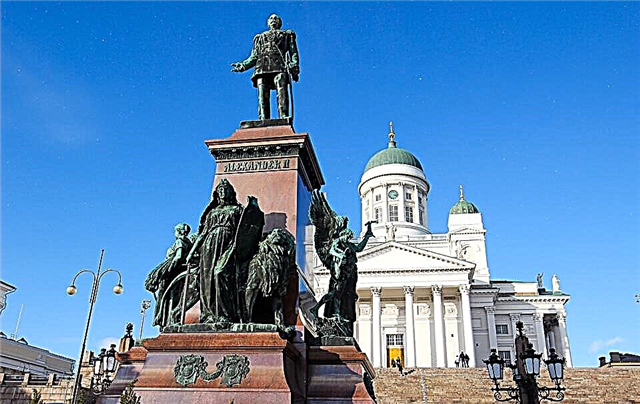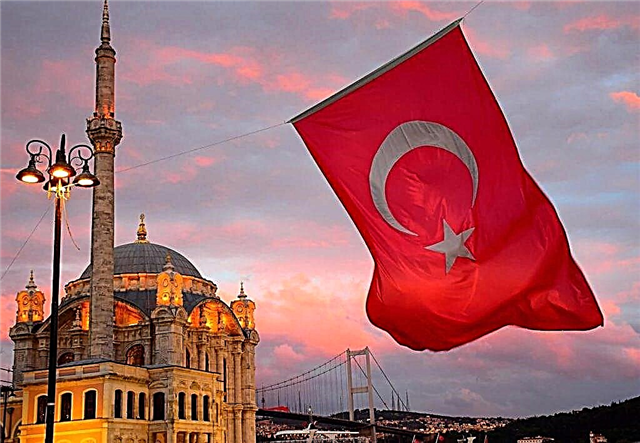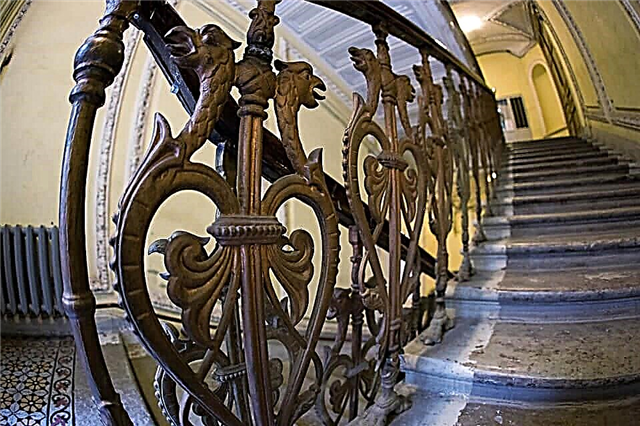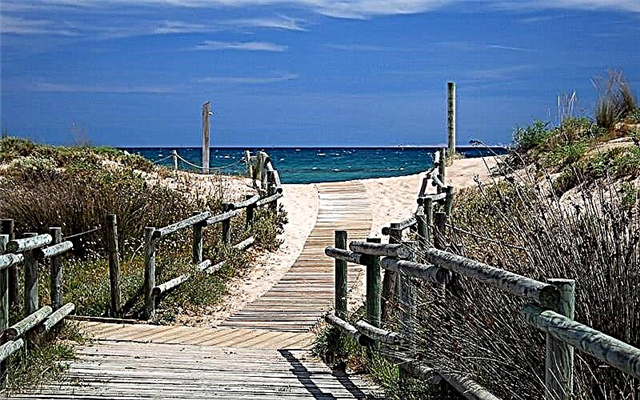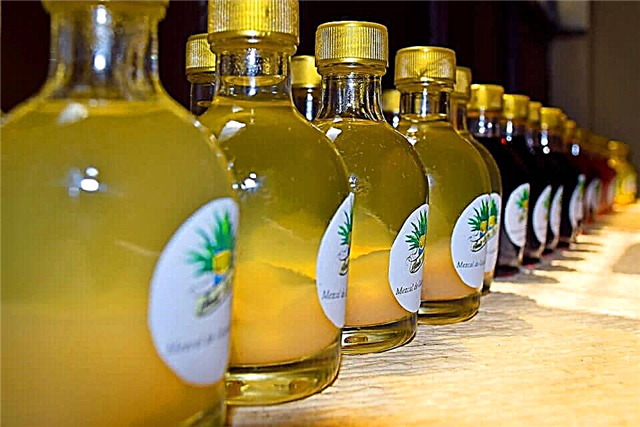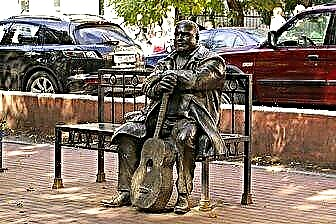The ancient Russian city of Tver was once the center of the powerful Tver principality, which vied with Moscow for leadership. But in 1485 it finally lost, became part of the Moscow state, and all the ambitions of the Tver princes remained in history.
Modern Tver is an important tourist center of Russia. The city has preserved many historical mansions of the 18th century, with which almost the entire Volga embankment is built up. Also of great interest are the churches of the 17th century, restored and kept in good condition.
The Volga River is worth a separate mention. Within the limits of Tver, its banks are dressed in picturesque embankments, where comfortable areas for recreation and walking have been created, and spectacular bridges are thrown across the river.

The best hotels and hotels at affordable prices.
from 500 rubles / day
What to see and where to go in Tver?
The most interesting and beautiful places for walking. Photos and a short description.
Monument to Mikhail Krug
The popular performer of Russian chanson Mikhail Krug was born in Tver. In 2002, he shared the fate of some of the heroes of his songs - he was killed in an armed attack. After the death of the singer, his relatives and friends began to raise funds for the installation of the monument. The monument appeared on the central boulevard of Tver in 2007. This event was preceded by protests of the city intelligentsia, but the authorities apparently decided that the personality of the Circle was worthy to perpetuate it on a par with Prince Mikhail of Tverskoy.

Afanasy Nikitin Embankment
The embankment stretches along the left bank of the Volga. There are many stylized restaurants and open-air verandas here, where tourists love to drop in during the warm season, and a simple walk along the alleys in this place can diversify your evening leisure. There are several monuments on the embankment in honor of famous historical figures, and there is also a city amusement park.

Stepan Razin Embankment
Central embankment, stretching along the right bank of the Volga. Local mansions, most of which were built in the 18th-19th centuries, are considered architectural monuments. The embankment begins at the City Garden, where the picturesque buildings of the Zvezda cinema and the House of Voroshilov Riflemen are located, then goes under the Novovolzhsky bridge and ends at the building of the women's diocesan school.

Tryokhsvyatskaya street
Pedestrian walking street, with a light hand nicknamed "Tverskoy Arbat". The street was built up in the 18th century after the master plan was approved. From 1901 to 1975, one of the first tram lines in the city operated here. Tryokhsvyatskaya street is one of the most picturesque in Tver. There are many cafes, souvenir shops, improvised venues for street music performances.

River Station
The building was erected in 1938 in the style of the so-called Stalinist Empire. For a long time, the station was an important transport point on the Volga. Until the end of the 80s. there were full-fledged river routes that connected Tver with Uglich and Rzhev, by the 2000s. only short pleasure trips remained. The station building looks spectacular from the side of docking ships, as passengers immediately see a monumental round rotunda and a sharp spire on the roof.

Travel palace
The complex is an architectural monument of the 18th century. The palace was built in the classical style with baroque elements according to the project of M. Kazakov. In the 19th century, the building was rebuilt by the architect K. Rossi at the request of his sister Alexander I. The palace is located between the City Garden and the Starovolzhsky Bridge right in the historic center of Tver. Since the 30s. XX century, the city art gallery is located here.

Yard of the Proletarian
Quarter of the mid-19th century, specially built for workers of the textile factory of industrialists Morozov. The houses were built of red bricks; the architecture of the buildings shows a clear influence of the "romanticized" Art Nouveau. The proletarian courtyard is a unique and picturesque landmark with enormous potential, but no one is involved in its restoration. People live in 100-year-old emergency dormitories; many buildings have broken glass and façade elements falling off.

Cinema Zvezda
The building of the cinema was erected in 1937 according to the project of V. Kalmykov. The architectural style is post-constructivism, located at the beginning of the Stepan Razin embankment. Until now, "Zvezda" performs its functions and is one of the largest cinemas in the city and the region. In five halls with a total capacity of more than 600 seats, new films from Russian and foreign cinema are constantly shown. The building is an object of cultural heritage of the Russian Federation.

House of Voroshilov riflemen
Another name for the building is the House of Red Commanders. The building is located on the embankment of Stepan Razin, it was erected in 1935 according to the project of V. Anferov. The house of Voroshilov riflemen was used as a military headquarters, hospital and military pedagogical institute. Nowadays on its territory there is a hotel and a hostel of the Military Academy of the East Kazakhstan region. G.K. Zhukov.

White Trinity Church
The temple is the oldest building on the territory of Tver. Its construction dates back to 1564. The building was rebuilt in the 18th and 19th centuries. Inside, an ancient iconostasis has been preserved, the wall painting belongs to a later period - the 19th-20th centuries. The church was built of white stone and brick, equipped with a hipped bell tower and several domes. The main shrine is a shrine with the relics of Makarii Kalyazinsky.

Church of the Three Confessors
The temple is located on the embankment of Afanasy Nikitin. Its construction began in 1728 after the dismantling of an old and dilapidated wooden church that was located on this site. The money for the work was allocated by the Tver merchant G. Sedov. The historic building was erected in the Baroque style, but as a result of later reconstructions, the Empire and early Classicism became the predominant styles. The original frescoes of the temple were destroyed during the Soviet era.

Ascension Cathedral
The temple is located in the center of Tver at the intersection of Tverskoy Prospekt and Sovetskaya Street. The building was erected in the middle of the 18th century, until that moment a wooden church with the same name already existed in its place. In 1936, the temple was closed, and an exhibition of the local museum of local lore was located on its territory. In 1972 the building was renovated, in 1991 it was returned to the Russian Orthodox Church.

Nativity of Christ monastery
A women's monastery, presumably operating since the 15th century (according to an alternative version, the monastery appeared in the 14th century). The complex was devastated during the Time of Troubles, after which it began to rapidly decline. Until the beginning of the 19th century, most of the buildings were wooden. Thanks to the generous donations of Countess A. Chernysheva, the monastery was rebuilt and renovated, many dilapidated buildings were replaced with new ones.

St. Catherine's convent
The monastery appeared in the 1920s. 17th century, at the end of the 18th century it was rebuilt from stone. During the Soviet period, the complex fell into disrepair, many buildings were dismantled or destroyed themselves. Divine services in the monastery church were resumed in 1989. The monastery gained the status of a full-fledged monastery in 1996. In the early 2000s. large-scale restoration work began, as a result of which the bell tower and several churches were restored.

Museum of M.E. Saltykov-Shchedrin
The opening of the museum was timed to coincide with the 150th anniversary of the writer. The exposition was housed in a memorial house of the 18th century, where Saltykov-Shchedrin lived for two years, while serving as vice-governor.Before the opening of the museum, the building housed several dozen communal apartments. The collection acquaints visitors with the everyday life, attitude and realities of the 19th century, as the writer perceived and saw it.

Goat museum
A new museum that opened in 2008. Since the 13th century, products from goat skins have been produced in Tver; until the end of the 18th century, the city was the largest supplier of tanned goat skin. There was even a separate microdistrict - Safyanovaya Sloboda, whose residents sewed morocco boots for the royal court. The exposition of the museum is devoted to the history of crafts associated with the production of products from goat skins, contains many different exhibits: stuffed animals, figurines and toys from various materials, coats of arms of countries and cities.

Museum of Tver Life
The exposition of the museum is dedicated to the history and traditions of Tver crafts, as well as various aspects of the life of the townspeople. The collection consists of various handicrafts, household items, church utensils, home textiles, clothing, jewelry and much more. There are even jewelry created in the 16th-19th centuries, old samovars and home weaving equipment. The museum was founded in 1970.

Tver Academic Drama Theater
The Tver theater troupe was formed in the middle of the 18th century at a theological seminary. By the end of the 19th century, the theater moved to the building of Gostiny Dvor, located on Millionnaya Street. Over the course of the 20th century, the premises were reconstructed several times in order to maximize its adaptation to the target needs. During the Great Patriotic War, the theater was destroyed, a new building was erected on the site of the old one.

Monument to Afanasy Nikitin
A native of Tver, Afansai Nikitin was a traveler, merchant and writer. In the period 1468-1474. he traveled to Persia, India, Muscat, Somalia and Turkey. On the basis of his impressions A. Nikitin created travel notes "Traveling across the three seas". The monument in honor of the pioneer was erected in 1955 on the left bank of the Volga. The sculpture is made of bronze, it reaches 4 meters in height and is installed on the base in the form of a boat.

Monument to Mikhail Tverskoy
The monument was opened in 2008, its installation was timed to the Day of Slavic Written Language and Culture. Prince Mikhail of Tverskoy is known for defeating the cavalry of the Horde Khan at the Battle of Bortenevo in 1317. This was the first major act of open disobedience to the Mongol-Tatars, for which the prince was sentenced to death. To avoid a punitive campaign against the Tver principality, Mikhail himself went to the khan and died.

Obelisk of Victory
The monument was erected in 1970 on the site of the church of St. Nicholas the Wonderworker (the building of the church was blown up in the 60s). The structure reaches a height of 45.5 meters, it was created with the participation of architects, sculptors and engineers who worked on the project as a team. The monument is installed on a foundation in the form of a torch bowl; at the foot there are bas-reliefs and texts that tell about the military exploits of the soldiers.

Starovolzhsky bridge
A graceful bridge over the Volga River, erected in 1897-1900. designed by engineers I. Mashek and V. Tochiskiy. The length of the structure reaches 215.5 m. With its outlines, the Starovolzhsky Bridge resembles the Freedom Bridge in Budapest. Until 1972, there were lanterns along the edges of the roadway of the structure, but then they were removed to Teatralnaya Square. In 1941, the bridge was blown up for strategic purposes, but in 1947 it was completely restored.

Novovolzhsky bridge
The structure was built in the 50s. XX century designed by A. Volovik. For the construction, the arched structures of the Lieutenant Schmidt Bridge of the 19th century were used, which were delivered to Kalinin (modern Tver) from St. Petersburg. The bridge was named Novovolzhsky, since the Starovolzhsky bridge was already functioning in the city. In 70 years, the city has grown, the capacity has decreased, and the structure has become in need of expansion.

Botanical Garden of Tver State University
The garden is located in the Zavolzhsky district of Tver. Its territory is home to 350 species of trees and shrubs, about 2000 species of grasses. Initially, these lands belonged to the Adolescent Monastery, but in 1879 the merchant I. Bobrov bought the territory and laid the park. The trees that Bobrov planted with his own hands still grow. Since 1989, the garden has been transferred to the Tver State University.

City garden
Protected area located on the site of the destroyed Tver Kremlin. The park appeared in 1931 as a result of the unification of the Governor's, Palace and Public Gardens. Park alleys are decorated with monuments to Mikhail Tversky, A. Pushkin, K. Marx. The city garden often becomes a venue for social events and celebrations. There are attractions and summer cafes for visitors.


